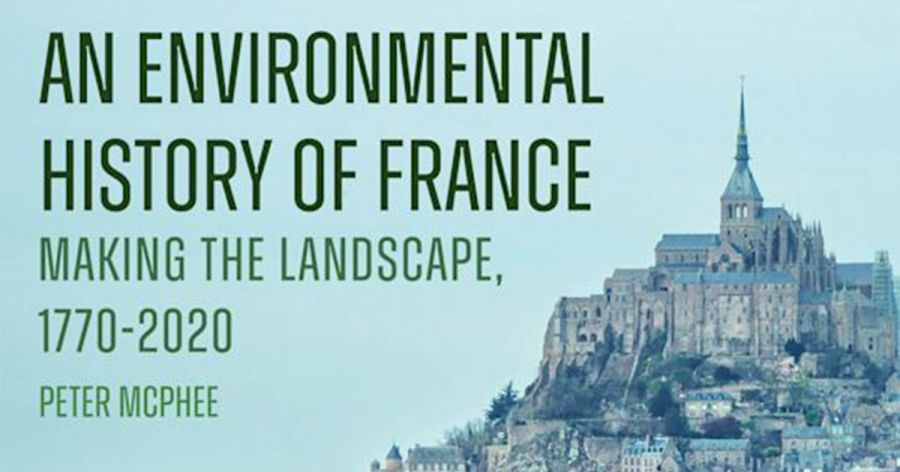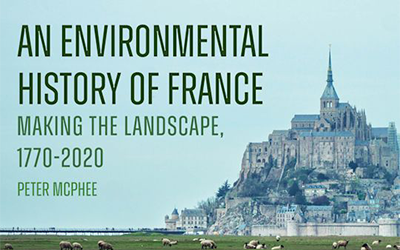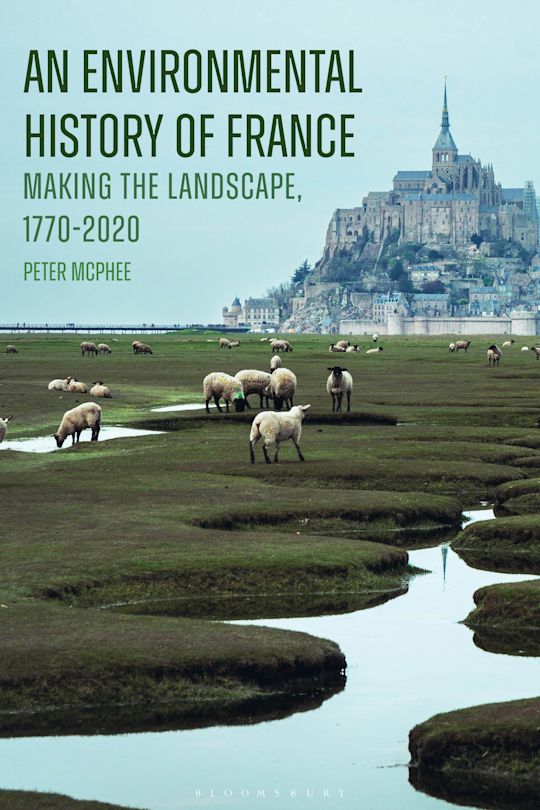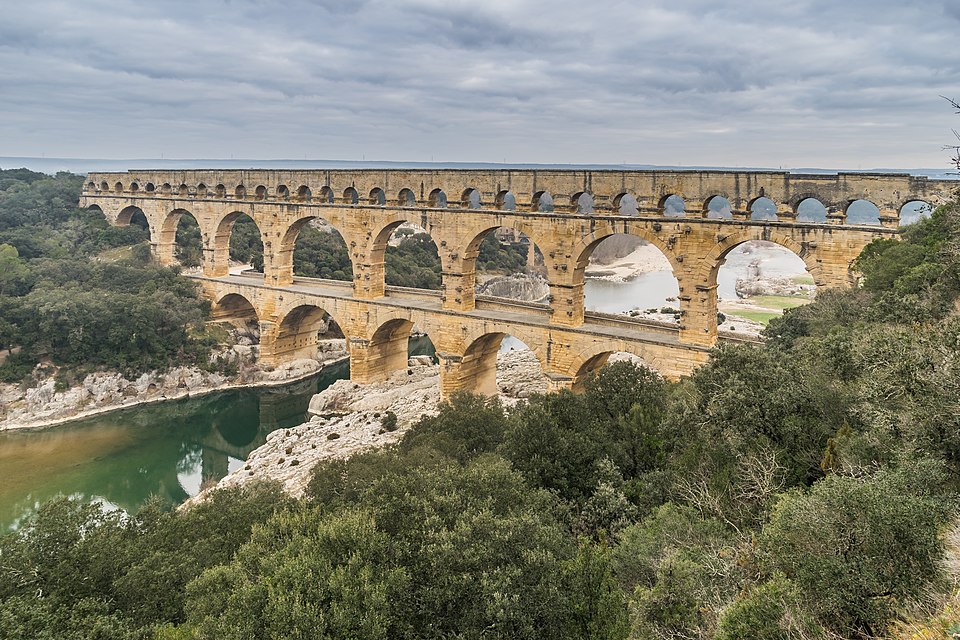
- Free Article: No
- Contents Category: France
- Review Article: Yes
- Article Title: 2,800 oaks per warship
- Article Subtitle: Human impact on French land
- Online Only: No
- Custom Highlight Text:
In a mountain area of south-eastern France that I know well, the locals will often respond to a comment on the beauty of the valleys by remarking glumly that they are not what they were: the forest is expanding, they say. We might see reforestation as a good thing, restoring hillsides devegetated and exposed to erosion by goats and sheep, but to them it marks the loss of a beloved familiar landscape. This bears out a point that Peter McPhee makes throughout his engaging new book, An Environmental History of France: that people have an idealised image of French landscapes, perceiving them as beautiful and timeless. In fact, he shows, they are the product of human activity, most markedly over the past 150 years. In that time, the bay around Mont-Saint-Michel has been largely reclaimed for farming, the hedgerows of Normandy have been destroyed, and freeways and fast train lines have sliced through the countryside.
- Featured Image (400px * 250px):

- Alt Tag (Featured Image): David Garrioch reviews ‘An Environmental History of France: Making the landscape, 1770-2020’ by Peter McPhee
- Book 1 Title: An Environmental History of France
- Book 1 Subtitle: Making the landscape, 1770-2020
- Book 1 Biblio: Bloomsbury, $35.99 pb, 224 pp
- Book 1 Cover Small (400 x 600):

- Book 1 Cover (800 x 1200):

- Book 1 Readings Link: https://www.readings.com.au/product/9781350523852/an-environmental-history-of-france--emeritus-professor-peter-mcphee--2024--9781350523852#rac:jokjjzr6ly9m
Local nostalgia for past landscapes sometimes contains a hint of protest, another theme running through McPhee’s narrative. The extension of forests has partly resulted from government action, against the wishes of local populations, who often had a keener sense of the vulnerability of the land. Among many examples, he describes the battles over the Landes, in the south-west, once a marshy region of sparse indigenous scrub and trees used for grazing sheep. In the 1850s and 1860s, the government forced the shepherds off, drained the marshes, and planted pine trees, which are very susceptible to fire. Ironically, the newly planted maritime pine forests came, in less than a century, to be seen by outsiders as the ‘natural’ landscape of the area.
Beneath the picturesque, McPhee uncovers the layered impacts of historical change, from the French Revolution to the European Common Agricultural Policy. Pressures of population and poverty, demand for food from urban centres, and improved transport all profoundly affected land use. Laws reinforcing individual ownership of land and the consolidation of farms facilitated tree felling and the enclosure of common lands. Monoculture dramatically changed the countryside, as did the canals and tree-lined straight roads that tourists admire today – largely the work of early nineteenth-century government engineers.
The modern landscape also reflects efforts to protect it from change. The Barbizon painters helped raise awareness of forest heritage in the 1850s, and after 1900 heritage associations proliferated, supported by the motoring association the Touring Club de France. More recently, environmentalists managed to stop the construction of a new airport at Notre-Dame-des-Landes, near Nantes. Landscape, McPhee points out, is in part something imagined, and it can be interpreted differently by viewers with varying perspectives. He shows the ways that landscape painting and literature express, at different moments, new understandings of the rural world.
 Pont du Gard, 2019 (photograph by Krzysztof Golik via Wikimedia Commons)
Pont du Gard, 2019 (photograph by Krzysztof Golik via Wikimedia Commons)
Publishers prefer broad headline titles that get keywords into search engines, and the subtitle is usually a better guide to the true contents. That is true here, yet this book extends well beyond its stated starting date, acknowledging inherited features such as the standing stones of Carnac and the Roman-built aqueduct, the Pont du Gard. McPhee lovingly describes the ancient terraces of southern and south-eastern France, the centuries-long canal and pond creations along the Somme river, and the enduring traces of now abandoned transhumance migrations of sheep and shepherds to alpine pastures.
Deforestation, too, was a long-term process. Nevertheless, McPhee argues strongly for 1770 as a turning point, noting the greater scale of change in the past 250 years. More important still, he insists, is that the shift from timber to coal began in the late eighteenth century, and with it the new era of the Anthropocene, when climatic change results from human activity rather than from geological or solar events. There is debate among environmental historians about the appropriate dating of the Anthropocene, and in France the extensive use of coal dates from the mid-nineteenth century, unlike in Britain, where it was already common in the 1600s. Emphasising the Anthropocene enables McPhee to make important points in the final chapters about the huge impact of industrial methods and thinking.
The relatively short time frame (for an environmental history) also enables its author to circumvent one of the problems of longue durée studies and to give due attention to immediate factors, what French historians call l’événementiel. One was the French Revolution of 1789-99, which saw perhaps a quarter of France’s forests illegally destroyed and massacres of fish and wild animals, sometimes by peasants taking revenge on seigneurs, or else when the poor seized a few hectares for crops and hunted game to help their families survive. Yet in some areas the Revolution encouraged better land use, such as planting vines or other crops better suited to the soil. In the longer term, its transformation of institutions and new definition of property were even more significant for the nation’s landscape, as later chapters reveal.
The mid-nineteenth century marked another turning point, with the reversal of rural population growth. Artisanal industry declined in the countryside, larger farms proliferated, and emigration to the towns was accelerated by the loss of chestnut trees, mulberries, and vines, all hit by fatal diseases. People in the village of Balazuc joked that the railway arrived just in time – to take away those who were now the newly unemployed. Meanwhile, wolves were also disappearing from the land, victims of hunting and of loss of habitat, including through reforestation with pines, rather than indigenous trees.
A further great upheaval came with World War I, when almost half of the forests, which had begun regenerating, were cut, largely for military use. It is bracketed with World War II, bookending an ‘Age of Catastrophe’ that had far-reaching consequences for rural France, some of them direct results of war, others linked to subsequent national reconstruction. The final chapter, ‘Living the Anthropocene’, points to the cumulative effects of climate change, but also to the impact of mass tourism, urban sprawl, monoculture and pesticides, and declining biodiversity. It summarises beautifully the struggles and competing interests around landscape preservation, including debates over hunting and around reintroducing wolves while trying to protect the interests of sheep farmers.
McPhee has an unfailing eye for the telling anecdote or statistic. Regional identities, he points out, were strengthened by the progressive introduction of appelations to protect local wines and cheeses. We better understand the impact of naval expansion when we learn that in the 1780s it took 2,800 ancient oaks to build a single warship.
This is masterful synthesis and humane history, reflecting its author’s vast knowledge of and deep affection for rural France.


Comments powered by CComment